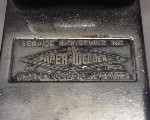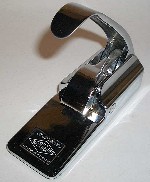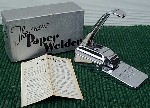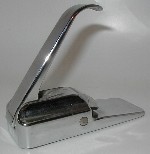Early Office Museum
Antique Stapler Gallery
~ Stapleless Paper Fasteners ~
|
Model, Year Introduced, Maker |
Click Image to Enlarge |
| Machines that Cut and Fold Papers to Fasten Them | |
| The Clipless and Bump Paper Fastener Companies In the beginning, the paper fasteners manufactured by the Clipless Paper Fastener Co. of Newton, IA, and the Bump Paper Fastener Co. (or Bump's Perfected Paper Fastener Co., as it was initially named) of La Crosse, WI, were based in part on the same inventions. A trade press article claimed that the "ingenious idea of a device for attaching sheets of paper together without the use of metal clips was conceived by George P. Bump in 1909 while working in a factory at Newton, Ia." (American Stationer, Apr. 15, 1916) However that may be, on May 14, 1909, George P. Bump, then of Newton, IA, applied for a US patent for inventions relating to paper fasteners. According to the same 1916 article, as soon as Bump had filed this patent application, he contracted with a manufacturer to supply him with a large quantity of paper fasteners based on his invention; it seems likely that the first fasteners were a hand-held model. Also in 1909, the Clipless Paper Fastener Co. was founded by J. C. Hawkins in Newton, IA. More on that in a moment. In 1911, Bump's 1909 patent application was divided into separate applications for patents for two inventions: The first invention pertained to a mechanism inside stapleless paper fasteners. The second invention pertained to a hand-held stapleless paper fastener. At some point between mid-1909 and mid-1910, Bump moved to La Crosse, WI. In 1911, US Patent No. 1,009,644 was awarded to Bump for the first invention; when this patent was issued, one-half was assigned to G. Hawkins of Newton, IA. In 1913, US Patent No. 1,065,903 was awarded to Bump for the second invention: when this patent was issued, one-half was assigned to J. C. Hawkins of Newton, IA. Presumably G. Hawkins and J. C. Hawkins were members of the same family. It appears that Bump may have worked for J. C. Hawkins when Bump made the relevant inventions mentioned above and applied for the initial patent in 1909. This relationship with Hawkins may be the reason that Bump assigned half of each patent to a member of the Hawkins family. However, both Bump and J. C. Hawkins were, among other things, inventors who obtained patents on a variety of machines. Therefore, they may have been jointly responsible for the inventions in Bump's 1909 patent application. The Hawkins family used its half-ownership of the '644 and '903 patents, along with additional patents awarded to J. C. Hawkins independent of Bump, for paper fasteners produced by the Clipless Paper Fastener Co. Bump used his half-ownership of the '644 and '903 patents, along with additional patents awarded to him independent of the Hawkins family, for paper fasteners produced for and later by the Bump Paper Fastener Co. Between 1909 and 1914, Bump had his paper fasteners manufactured by another company. In 1914 Bump began to manufacture them himself. (American Stationer, Apr. 15, 1916) The Clipless Paper Fastener Co. disappeared immediately after 1922. In 1930, with an investor named Quincy H. Hale, Bump established the Bump Mfg. Co. to produce various types of machinery, including pumps. Then, in 1931, Ralph E. McKenzie of La Crosse, WI, an inventor and manufacturer of potato farm machinery, purchased a controlling interest in the Bump Mfg. Co. George Bump moved from corporate management to engineering. Between 1941 and 1956, the Bump Pump Co. of La Crosse, WI, produced various types of pumps. The relationships among the Bump Paper Fastener Co., the Bump Mfg. Co., and the Bump Pump Co. are not clear. It may be that Bump Mfg. included Bump Paper Fastener and that Bump Pump included Bump Mfg. As we will see below, the Bump Paper Fastener Co. advertised a new model in 1934, but at about the same time Bump stopped producing paper fasteners. In 1942, however, Bump resumed production of paper fasteners and sold them until about 1950. Meanwhile, George P. Bump died in 1947 at the age of 77. The first stapleless paper fastener models sold by Bump and Clipless were hand-held models, which were introduced in 1909 [confirm date]. These are not discussed further on this web site; a discussion will be added. |
. |
| Bump's New Model Paper
Fastener Patent Application 1910 ~ US Patent No. 1,065,904 awarded in 1913 to George P. Bump of La Crosse, WI Advertised 1910-11 Bump Paper Fastener Co. La Crosse, WI Presumably this was named "New Model" because it was preceded by a hand-held model. |
 |
| Clipless Stand Machine Patent Application 1911 ~ US Patent No. 1,173,425 awarded in 1916 to J. C. Hawkins, Newton, IA ~ Advertised 1910-23 Clipless Paper Fastener Co. Newton, IA According to an article published in Oct. 1911, this machine had been on the market for about 18 months, which implies that it was first marketed early in 1910. However, a June 1910 advertisement for Clipless paper fasteners refers only to a hand model, not a stand machine designed to sit on a desktop. It may be that the Clipless stand machine was not on the market until 1911 but the company claimed it was on the market in 1910 to create the impression that it was first marketed no later than Bump's New Model Paper Fastener. We will try to sort this out. |
|
| Remo Paper Fastener 1913 Fielding-Behrend Stationery Co. (selling agent, in business only during 1913) New York, NY |
Picture coming |
| Paper Fastener Advertised 1913 (France) It is not clear whether this is a stapleless paper fastener. |
 |
| Bump Stand Model Paper
Fastener and Punch Patent Application 1917 ~ US Patent No. 1,283,063 awarded in 1918 to George P. Bump Advertised 1916-19, 1928, 1942-43, 1950 Bump Paper Fastener Co. La Crosse, WI The rear of this machine punched a 1/4th inch round hole. A 1942 trade press article stated that the Bump paper fastener was back on the market after a 10-year absence. This implies that the machine was not sold during 1933-41. A substantially different Bump paper fastener (see below) was advertised in 1934. During World War II, the device in the photo to the right was produced with black oxidized finish because of government restrictions on the use of nickel. |
 |
| Junior Paper Fastener Patented 1915 ~ Introduced 1918 ~ Advertised 1918-20 Automatic Pencil Sharpener Co. Chicago, IL |
|
| Dexter Paper Fastener Advertised 1919-20 Automatic Pencil Sharpener Co. Chicago, IL |
|
| The B-B Bynd Blot Clipless Paper Fastener and Blotter (a.k.a. Puck Clipless Paper Fastener and Blotter) Bynd-Blot announced in trade press Dec. 1921 and advertised 1922 Puck advertised 1922-23 Karbonax Ltd. London, England The underside of the base holds a blotter. The name "Bynd-Blot" is awkward. "Bynd" is pronounced "bind." The name therefore means "fasten papers & blot ink." Presumably the name was changed to the simpler "Puck" during 1922. Karbonax Ltd. was liquidated at the end of 1925. |
 |
| Bump Paper Fastener Introduced 1934 ~ Advertised 1934 Bump Paper Fastener Co. La Crosse, WI |
 |
| Ideal Clipless Paper
Fastener
Japan Photograph courtesy of Rev. Donald Lindgren |
|
| Machines that Crimp Papers to Fasten Them | |
| New Paper Punch Advertised 1903 Auto-Device Mfg. Co. Chicago, IL "You can attach a check, receipt or memorandum to a letter or paper without the use of pins, clips or fasteners. You don't have to buy materials to feed this punch. It uses the sheets themselves by crimping them." |
Image coming from System 1903 |
| Fermafix Paper Binder (a.k.a. Krimp'It Paper Crimper, Turner Multigrip, and Turner's Multigrip with Adgoods Retarder, Patent filed 1923 (Hungary). Patents awarded 1925 (Germany) & 1933 (UK) Patents filed 1931 & 1932 (US), awarded 1934 (US Patent Nos. 1,954,965 and 1,960,059) Advertised 1930 (Fermafix, UK), 1932 (Krimp'It, US) Made by Ferma Ltd., London, UK; Seiders-Mather Corp., Chicago, IL; Turner Manufacturing Ltd, Wolverhampton, UK; Adgoods Ltd., London, UK. Also sold with a German language nameplate. This machine fastened papers by crimping them together as they passed between two knurled wheels. The crimp could be the full length or width of the papers. There were several similar models with various improvements, and they were made by several companies in several countries. For a patent for an improvement, in addition to those listed above,see US Patent No. 1,939,571, filed 1932, issued to Fritz Rau, Munich, Germany, 1933. For additional information on the Krimp'It and the Seiders-Mather Corp., see Curtis Scaglione's website, MyStaplers.com. |
|
| Paper Welder (first model) Patent application 1936. US Patent No. 2,188,222 issued 1940 to Ralph M. Hibbs. This patent describes the mechanism used by the Paper Welder to attach papers. The images of the machine in the patent diagram do not look at all like the Paper Welder. Patent application 1939. US Patent No. 2,275,111 issued 1942 to Norman S. Noll. The images of the machine in the patent diagram resemble the Paper Welder. Paper Welders (marked "Boston")were marketed in 1940 and probably before that. Insert photo. A product review for the Paper Welder was published in 1940. The first model of the Paper Welder was advertised during 1941-52 by Service Industries, Inc., which was located in Boston, MA, c. 1936-40, and Middleport, NY, c. 1940-52. The Paper Welder fastened papers by compressing them between hardened steel welding dies that crimped the papers together.  Enlarged image of "weld" that holds papers together. A user could "iron out" the weld with a fingernail or other smooth object. The discussion of the Paper Welder presented here and in the row below benefited considerably from the interesting and informative research results presented by Frank Parsons in his American Stationer website at https://americanstationer.wordpress.com/tag/paper-welder/ |
 Left: First model Paper Welder (c. 1940-52) Left: First model Paper Welder (c. 1940-52)Right: Second model Paper Welder (c. 1952-84). The Second model is discussed below.  Service Industries, Inc., Boston, MA, identification on a first model Paper Welder, produced 1936-40, while patent application was pending. Service Industries, Inc., Boston, MA, identification on a first model Paper Welder, produced 1936-40, while patent application was pending. |
| Paper Welder (second model) In addition to patents identified for the first model Paper Welder immediately above, the second model was covered by a new design patent: Patent application 1955. U.S. Patent No. D178,628 awarded 1956 to Norman Bathrick and Leo Collins and assigned to Bathrick-Collins, Inc., Medina, NY. Advertised 1952-84 Service Industries, Inc., Middleport, NY, c. 1952-54 Bathrick-Collins Inc., Medina, NY, c. 1955-57 Paper Welder Inc., Medina, NY, 1957-84 The second model Paper Welder was smaller and lighter than the first model (discussed immediately above). Also, the second model was chrome plated. Initially, the top of the base of the second model had a prominent embossed design that included the company name. See two top photos to the right. Later, this information was put on the underside of the lever, giving the machine a cleaner appearance. See bottom photo to the right. A 1963 advertisement stated: "The welder will fasten together up to six sheets and requires no refills." A 1966 trade press discussion stated: "To save space in the files, a paper welder...is recommended. The advantage is that the welded papers lie flat so that files do not become unbalanced." The Paper Welder was an expensive paper fastener. The price was $15.95 in 1963; $13.93 in 1966; and $16.95 in 1978. Adjusted using the BLS Consumer Price Index, the $15.95 price in 1963 is equivalent to a price of $122 at the beginning of 2014! Annual production of Paper Welders peaked at approximately 25,000 units in the 1960s. Output then declined for two reasons. First, competition from knock-offs made in Japan and elsewhere became significant after 1970. Second, the cost of chrome plating increased. The profit margin on the Paper Welder was squeezed considerably between 1963 and 1978. Over that period: 1. The price of chrome increased 200%. (U.S. Geological Survey, Metal Prices in the United States Through 1998," p. 26. 2. The BLS Consumer Price Index increased 113%. 3. The price of the Paper Welder increased only 6%! In the late 1970s, Paper Welder, Inc., introduced a gold-tone Paper Welder in an effort to expand sales. This was a failure. Total production was around 100 units. Production of Paper Welders ceased in 1984. The information on the second model Paper Welder presented here was obtained largely from the interesting and informative research results presented by Frank Parsons in his American Stationer website at https://americanstationer.wordpress.com/tag/paper-welder/ |
 Paper Welder, second model, produced by Service Industries, Middleport, NY, c. 1952-54, identification to top of base. Paper Welder, second model, produced by Service Industries, Middleport, NY, c. 1952-54, identification to top of base. Paper Welder produced by Bathrick-Collings, Inc., Medina, NY, c. 1955-57, identification to top of base. Paper Welder produced by Bathrick-Collings, Inc., Medina, NY, c. 1955-57, identification to top of base. Paper Welder produced by Paper Welder, Inc., Medina, NY, 1958-84, name hidden under lever, giving cleaner appearance. Paper Welder produced by Paper Welder, Inc., Medina, NY, 1958-84, name hidden under lever, giving cleaner appearance. |